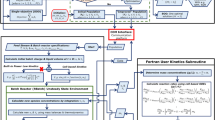Abstract
The biochemical process industry is often confronted with the challenge of making decisions in an atmosphere of multiple and conflicting objectives. Recent innovations in the field of operations research and systems science have yielded rigorous multicriteria optimization techniques that can be successfully applied to the field of biochemical engineering. These techniques incorporate the expert's experience into the optimization routine and provide valuable information about the zone of possible solutions. This paper presents a multicriteria optimization strategy that generates a Pareto domain, given a set of conflicting objective criteria, and determines the optimal operating region for the production of gluconic acid using the net flow method (NFM). The objective criteria include maximizing the productivity and concentration of gluconic acid, while minimizing the residual substrate. Three optimization strategies are considered. The first two strategies identify the optimal operating region for the process inputs. The results yielded an acceptable compromise between productivity, gluconic acid concentration and residual substrate concentration. Fixing the process inputs representing the batch time, initial substrate concentration and initial biomass equal to their optimal values, the remaining simulations were used to study the sensitivity of the optimum operating region to changes in the oxygen mass transfer coefficient, K L a, by utilizing a multi-level K L a strategy. The results show that controlling K L a during the reaction reduced the production of biomass, which in turn resulted in increased productivity and concentration of gluconic acid above that of a fixed K L a.








Similar content being viewed by others
Abbreviations
- C :
-
dissolved oxygen concentration in the broth, gl-1
- c k :
-
individual concordance index
- C k :
-
global concordance index
- C*:
-
concentration of oxygen in liquid in equilibrium with gas phase, gl-1
- D k :
-
discordance index
- K L a :
-
avolumetric oxygen transfer coefficient, h-1
- k l :
-
Michaelis constant for lactone production, gl-1
- k p :
-
gluconolactone hydrolysis rate constant, h-1
- k o :
-
Monod rate constant of growth with respect to oxygen, gl-1
- k s :
-
Monod rate constant of growth with respect to glucose, gl-1
- L :
-
gluconolactone concentration, gl-1
- P :
-
gluconic acid concentration, gl-1
- P f :
-
final gluconic acid concentration, gl-1
- P f /t B :
-
gluconic acid productivity, gl-1h-1
- P k :
-
preference threshold
- P/V :
-
power supply for agitation in the reactor, Wm-3
- Q k :
-
indifference threshold
- S :
-
substrate concentration, gl-1
- S o :
-
initial substrate concentration, gl-1
- t B :
-
batch time, h
- t :
-
time, h
- U g :
-
superficial gas velocity of air entering the reactor, ms-1
- V k :
-
veto threshold
- v l :
-
velocity constant for lactone production, mg UOD-1h-1
- W k :
-
weight, dimensionless
- X :
-
cell concentration, UOD ml-1
- Xo :
-
initial cell concentration, UOD ml-1
- Y o :
-
yield of growth based on oxygen, UOD mg-1
- Y s :
-
yield of growth based on glucose, UOD mg-1
- μ m :
-
maximum specific growth rate, h-1
References
Edgar TF, Himmelblau DM, Lasdon LS (2001) Optimization of chemical processes, 2nd edn. McGraw-Hill, New York
Thibault J, Taylor D, Fonteix C (2001) Multicriteria optimization for the production of gluconic acid. In: D. Douchain, M. Perrier (eds) Proceedings of the 8th International Conference on Computer applications in biotechnology: modeling and control of biological processes. IFAC, Quebec, pp 24–27
Ringuest JL (1992) Multiobjective optimization: behavioral and computational considerations. Kluwer, Dordrecht
Bull DN, Kempe LL (1970) Kinetics of the conversion of glucose to gluconic acid by Pseudomonas ovalis. Biotechnol Bioeng 12:273–290
Johansen TA, Foss BA (1995) Semi-empirical modelling of non-linear dynamic systems through identification of operating regimes and local models. In: Hunt K, Irwin G, Warwick K (eds) Neural network engineering in control systems. Springer-Verlag, Berlin Heidelberg New York, pp 105–126
Ghose TK, Gosh P (1976) Kinetic analysis of gluconic acid production by Pseudomonas ovalis. J Appl Chem Biotechnol 26:768–777
Bulock J and Kristiansen B (eds) (1987) Basic biotechnology. Academic Press, New York, pp 149–172
Gagnon H, Lounes M, Thibault J (1998) Power consumption and mass transfer in agitated gas–liquid columns: a comparative study. Can J Chem Eng 76:379–389
Trevan MD, Boffey S, Goulding KH, Stranbury P (1987) Biotechnology: the biological principles. Taylor and Francis, London
Perrin E, Mandrille A, Oumoun M, Fonteix C, Marc I (1997) Optimisation globale par stratégie d'évolution: technique utilisant la génétique des individus diploïdes. RAIRO-Rech Opérat 31:161–201
Roy B (1978) ELECTRE III: algorithme de classement basé sur une présentation floue des préférences en présence de critères multiples. Cah CERO 20:3–24
Brans JP, Mareschal B, Vincke Ph (1984) Promethee: a new family of outranking methods in multicriteria decision making. In: Operational research 84. North Holland, Amsterdam, pp. 477–490
Derot B, Gareau J, Kiss LN, Martel JM (1997) The solver of Volvox multicriteria table. In: Climaio J (ed) Multicriteria analysis. Springer-Verlag, Berlin Heidelberg New York, pp 113–126
Triantaphyllou E (2000) Multicriteria decision making methods: a comparative study. Kluwer, Dordrecht
Author information
Authors and Affiliations
Corresponding author
Rights and permissions
About this article
Cite this article
Halsall-Whitney, H., Taylor, D. & Thibault, J. Multicriteria optimization of gluconic acid production using net flow. Bioprocess Biosyst Eng 25, 299–307 (2003). https://doi.org/10.1007/s00449-002-0309-6
Received:
Accepted:
Published:
Issue Date:
DOI: https://doi.org/10.1007/s00449-002-0309-6




